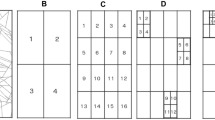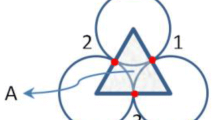Abstract
Almost all conventional discrete fracture network (DFN) models embedded within rock masses are discontinuities with zero tensile strength and mean values of geomechanical parameters. However, the spatial variability and networks of weak and strong potential failure planes and discontinuities have a significant effect on rock mass behaviour. Therefore, the geomechanical heterogeneous nature of potential failure planes and fractures, along with their geometrical parameters, is crucial for understanding rock mass behaviour. To bridge this gap in research, this paper provides a methodology for stochastic modelling of potential failure plane and discontinuity geomechanical properties effects on rock mass behaviour using a combination of DFN and discrete element modelling approach. Due to the uncertainties and distributed geomechanical characteristics of DFN, fracturing may occur through an intact part, DFN, or a combination of intact and DFN. A parametric study was performed to investigate the influence of friction angle, normal and shear stiffness, cohesion, and tensile strength of potential failure planes and discontinuities. The results indicate that the proposed stochastic geomechanical DFN model gives more realistic rock mass strengths and failure patterns compared to the conventional DFN framework.
Similar content being viewed by others
References
Bandis, S.C., Lumsden, A.C., Barton, N.R.: Fundamentals of rock joint deformation. Int. J. Rock Mech. Min. Sci. Geomech. Abstr. 20(6), 249–268 (1983)
Bewick, R.P., Kaiser, P.K., Amann, F.: Strength of massive to moderately jointed hard rock masses. J. Rock Mech. Geotech. Eng. 11(3), 562–575 (2019). https://doi.org/10.1016/j.jrmge.2018.10.003
Brzovic, A., Herrera, S.: Assessing geological vein size and intensity using Discrete Fracture Network modelling at the El Teniente Mine, Chile. In: 45th US Rock Mechanics/Geomechanics Symposium (2011).
Brzovic, A., Schachter, P., De Los Santos, C., Vallejos, J., Mas Ivars, D.: Characterization and synthetic simulations to determine rock mass behaviour at the El Teniente Mine, Chile. Part I. In: Proceedings of the 3rd International Symposium on Block and Sublevel Caving, Santiago, Chile 171–178 (2014).
Brzovic, A., Villaescusa, E.: Rock mass characterization and assessment of block-forming geological discontinuities during caving of primary copper ore at the El Teniente mine, Chile. Int. J. Rock Mech. Min. Sci. 44(4), 565–583 (2007). https://doi.org/10.1016/j.ijrmms.2006.09.010
Cruz, T.V.G., Pierce, M.E.: A 3DEC model for heavily veined massive rock masses, American Rock Mechanics Association. 48th US Rock Mechanics/Geomechanics Symposium held in Minneapolis (2014), MN, USA, 1–4 June.
Day JJ.: The influence of healed intrablock rockmass structure on the behaviour of deep excavations in complex rockmasses. Doctoral dissertation, Queen’s University, Canada; (2016).
Day, J.J., Diederichs, M.S., Hutchinson, D.J.: New direct shear testing protocols and analyses for fractures and healed intrablock rockmass discontinuities. Eng. Geol. 229, 53–72 (2017). https://doi.org/10.1016/j.enggeo.2017.08.027
Debecker, B., Vervoort, A.: Two-dimensional discrete element simulations of the fracture behaviour of slate. Int. J. Rock Mech. Min. Sci. 61, 161–170 (2013). https://doi.org/10.1016/j.ijrmms.2013.02.004
Debecker, B., Tavallali, A., Vervoort, A.: Probability distribution of rock properties: effect on the rock behaviour. In 6th International Symposium on Ground Support Min. Civil Eng. Construct; (2008) 357–368.
Evans, R.H., Marathe, M.S.: Microcracking and stress-strain curves for concrete in tension. Matériaux et Construction. 1(1), 61–64 (1968)
Farahmand, K., Vazaios, I., Diederichs, M.S., Vlachopoulos, N.: Investigating the scale-dependency of the geometrical and mechanical properties of a moderately jointed rock using a synthetic rock mass (SRM) approach. Comput. Geotech. 95, 162–179 (2018). https://doi.org/10.1016/j.compgeo.2017.10.002
Fathipour-Azar, H., Wang, J., Jalali, S.M., Torabi, S.R.: Numerical modeling of geomaterial fracture using a cohesive crack model in grain-based DEM. Comput. Part. Mech. 7(4), 645–654 (2020). https://doi.org/10.1007/s40571-019-00295-4
Fathipour-Azar, H.: Machine learning-assisted distinct element model calibration: ANFIS, SVM, GPR, and MARS approaches. Acta Geotech. 17, 1207–1217 (2022). https://doi.org/10.1007/s11440-021-01303-9
Gao, F.Q., Kang, H.P.: Effects of pre-existing discontinuities on the residual strength of rock mass–Insight from a discrete element method simulation. J. Struct. Geol. 85, 40–50 (2016). https://doi.org/10.1016/j.jsg.2016.02.010
Hamdi, P., Stead, D., Elmo, D.: Characterizing the influence of stress-induced microcracks on the laboratory strength and fracture development in brittle rocks using a finite-discrete element method-micro discrete fracture network FDEM-μDFN approach. J. Rock. Mech. Geotech. Eng. 7(6), 609–625 (2015). https://doi.org/10.1016/j.jrmge.2015.07.005
Itasca. Itasca Consulting Group Inc., The Universal Distinct Element Code (UDEC), Ver. 6.0., Minneapolis, USA; (2014).
Ivars, D.M., Pierce, M.E., Darcel, C., Reyes-Montes, J., Potyondy, D.O., Young, R.P., Cundall, P.A.: The synthetic rock mass approach for jointed rock mass modelling. Int. J. Rock Mech. Min. Sci. 48(2), 219–244 (2011). https://doi.org/10.1016/j.ijrmms.2010.11.014
Jakubec, J., Board, M., Campbell, R., Pierce, M., Zaro, D.: Rock mass strength estimate—Chuquicamata case study. In: Proceedings MassMin; (2012) 10–4.
Jakubec, J.: Role of defects in rock mass classification. In: Ground Support 2013: Proceedings of the Seventh International Symposium on Ground Support in Mining and Underground Construction. Australian Centre for Geomechanics; (2013) 337–344.
Jing, L., Stephansson, O.: Fundamentals of discrete element methods for rock engineering: theory and applications. Elsevier; (2007).
Kovari, K., Tisa, A., Einstein, H.H., Franklin, J.A.: Suggested methods for determining the strength of rock materials in triaxial compression: revised version. Int. J. Rock Mech. Min. Sci. Geomech. Abstr. 20(6), 285–290 (1983)
Laubscher, D.H., Jakubec, J.: The MRMR rock mass classification for jointed rock masses. Underground Mining Methods: Engineering Fundamentals and International Case Studies, WA Hustrulid and RL Bullock (eds) Society of Mining Metallurgy and Exploration, SMME; (2001) 475–81.
Lei, Q., Latham, J.P., Tsang, C.F.: The use of discrete fracture networks for modelling coupled geomechanical and hydrological behaviour of fractured rocks. Comput. Geotech. 85, 151–176 (2017). https://doi.org/10.1016/j.compgeo.2016.12.024
Lorig, L.J., Darcel, C., Damjanac, B., Pierce, M., Billaux, D.: Application of discrete fracture networks in mining and civil geomechanics. Min. Technol. 124(4), 239–254 (2015). https://doi.org/10.1179/1743286315Y.0000000021
Lu, Y., Martin, C.D., Lan, H.: Strength of intact rock containing flaws. In: 47th US Rock Mechanics/Geomechanics Symposium; (2013).
Mayer, J.M., Stead, D.: Exploration into the causes of uncertainty in UDEC grain boundary models. Comput. Geotech. 82, 110–123 (2017). https://doi.org/10.1016/j.compgeo.2016.10.003
Munjiza, A.A.: The combined finite-discrete element method. John Wiley & Sons; (2004).
Pierce, M., Gaida, M., DeGagne, D.: Estimation of rock block strength. InRockEng09. In: Proceedings 3rd CANUS Rock Mechanics Symposium, Toronto; (2009).
Pine, R.J., Coggan, J.S., Flynn, Z.N., Elmo, D.: The development of a new numerical modelling approach for naturally fractured rock masses. Rock Mech. Rock Eng. 39(5), 395–419 (2006). https://doi.org/10.1007/s00603-006-0083-x
Pine, R.J., Owen, D.R., Coggan, J.S., Rance, J.M.: A new discrete fracture modelling approach for rock masses. Geotechnique 57(9), 757–766 (2007). https://doi.org/10.1680/geot.2007.57.9.757
Shang, J., Hencher, S.R., West, L.J.: Tensile strength of geological discontinuities including incipient bedding, rock joints and mineral veins. Rock Mech. Rock Eng. 49(11), 4213–4225 (2016). https://doi.org/10.1007/s00603-016-1041-x
Sinha, S., Walton, G.: Investigation of pillar damage mechanisms and rock-support interaction using Bonded Block Models. Int. J. Rock Mech. Min. Sci. 138, 104652 (2021). https://doi.org/10.1016/j.ijrmms.2021.10465
Staub, I., Fredriksson, A., Outters, N.: Strategy for a Rock Mechanics Site Descriptive Model. Development and testing of the theoretical approach. Swedish Nuclear Fuel and Waste Management Co.; (2002).
Stavrou, A., Vazaios, I., Murphy, W., Vlachopoulos, N.: Refined approaches for estimating the strength of rock blocks. Geotech. Geol. Eng. 37(6), 5409–5439 (2019). https://doi.org/10.1007/s10706-019-00989-9
Tang, C.A., Lü, H.Y.: The DDD method based on combination of RFPA and DDA. Frontiers of Discontinuous Numerical Methods and Practical Simulations in Engineering and Disaster Prevention. London: Taylor & Francis Group; (2013) 105–2.
Tatone, B.S.: Investigating the evolution of rock discontinuity asperity degradation and void space morphology under direct shear. Doctoral dissertation, University of Toronto, Canada; (2014).
Tavallali, A., Vervoort, A.: Effect of layer orientation on the failure of layered sandstone under Brazilian test conditions. Int. J. Rock Mech. Min. Sci. 47(2), 313–322 (2010). https://doi.org/10.1016/j.ijrmms.2010.01.001
Turichshev, A., Hadjigeorgiou, J.: Development of synthetic rock mass bonded block models to simulate the behaviour of intact veined rock. Geotech. Geol. Eng. 35(1), 313–335 (2017a). https://doi.org/10.1007/s10706-016-0108-5
Turichshev, A., Hadjigeorgiou, J.: Quantifying the effects of vein mineralogy, thickness, and orientation on the strength of intact veined rock. Eng. Geol. 226, 199–207 (2017b). https://doi.org/10.1016/j.enggeo.2017.06.009
Vallejos, J.A., Brzovic, A., Lopez, C., Bouzeran, L., Ivars, D.M.: Application of the Synthetic Rock Mass approach to characterize rock mass behavior at the El Teniente Mine, Chile. In: FLAC/DEM Symposium, Minneapolis; (2013).
Vallejos, J.A., Suzuki, K., Brzovic, A., Ivars, D.M.: Application of synthetic rock mass modeling to veined core-size samples. Int. J. Rock Mech. Min. Sci. 81, 47–61 (2016). https://doi.org/10.1016/j.ijrmms.2015.11.003
Vervoort, A., Debecker, B., Lysebetten, G.V.: Discrete Simulation of Fracturing and Failure of Rock Samples. InInternational Conference on Discrete Element Methods. Springer, Singapore; (2016) 855–862.
Virgo, S., Abe, S., Urai, J.L.: The evolution of crack seal vein and fracture networks in an evolving stress field: Insights from Discrete Element Models of fracture sealing. J. Geophys. Res. Solid Earth 119(12), 8708–8727 (2014). https://doi.org/10.1002/2014JB011520
Vyazmensky, A., Stead, D., Elmo, D., Moss, A.: Numerical analysis of block caving-induced instability in large open pit slopes: a finite element/discrete element approach. Rock Mech. Rock Eng. 43(1), 21–39 (2010). https://doi.org/10.1007/s00603-009-0035-3
Author information
Authors and Affiliations
Corresponding author
Ethics declarations
Competing interest
The authors declare that they have no known competing financial interests or personal relationships that could have appeared to influence the work reported in this paper.
Additional information
Publisher's Note
Springer Nature remains neutral with regard to jurisdictional claims in published maps and institutional affiliations.
Rights and permissions
Springer Nature or its licensor (e.g. a society or other partner) holds exclusive rights to this article under a publishing agreement with the author(s) or other rightsholder(s); author self-archiving of the accepted manuscript version of this article is solely governed by the terms of such publishing agreement and applicable law.
About this article
Cite this article
Fathipour‑Azar, H., Wang, J., Jalali, S.E. et al. The use of stochastic geomechanical properties of potential failure plane and fracture networks for realistic modelling of rock mass behaviour: A synthetic rock mass modelling (SRM) study. Comput Geosci 27, 391–406 (2023). https://doi.org/10.1007/s10596-023-10205-6
Received:
Accepted:
Published:
Issue Date:
DOI: https://doi.org/10.1007/s10596-023-10205-6




